How To Develop Ai Chatbot with No Coding?
In this article, we delve into the dynamic world of AI chatbots, exploring their development from basic automated responders to advanced conversational agents powered by neural networks and natural language processing. We cover the essential steps in creating an AI chatbot, including designing conversation flow and integrating artificial intelligence. Additionally, the article provides insights into the future of chatbot technology, highlighting emerging trends and the potential impact of these advancements on various industries.
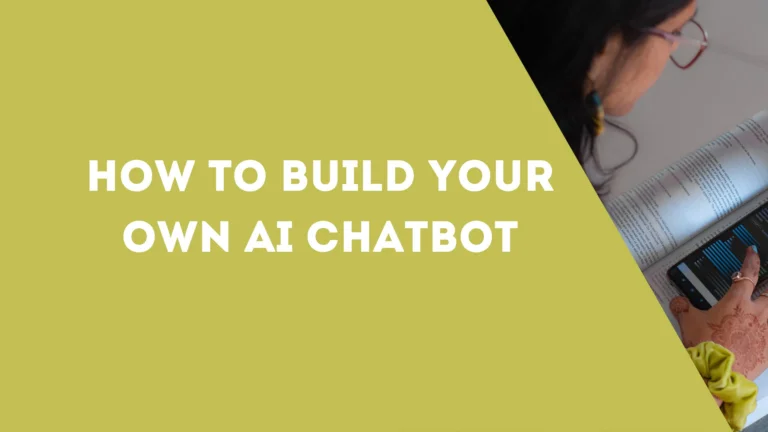
How to build your own ai chatbot
Introduction: how to develop AI chatbot
In the rapidly evolving digital landscape, AI chatbots have emerged as a pivotal innovation, transforming how businesses interact with their customers. These intelligent chatbot solutions, powered by artificial intelligence (AI) and natural language processing (NLP), are redefining the norms of customer engagement across various industries. By incorporating AI, these chatbots are capable of understanding and processing human language, enabling them to handle complex queries with ease.
The process of how to build an AI chatbot involves a blend of AI development, NLP techniques, and understanding user preferences, making them not just responsive but also intuitive. From simple queries on social media channels to providing instant responses in customer service, AI chatbots are becoming an indispensable tool for businesses. They seamlessly integrate into existing platforms, offering custom chatbot solutions that cater to specific tasks and user experiences.
As the demand for more sophisticated and human-like interactions grows, the role of AI chatbots in enhancing chatbot conversations, managing user inputs, and learning from human interactions continues to expand. Whether it’s through rule-based systems or more advanced neural networks, the journey of building chatbots is constantly evolving, offering endless possibilities for businesses to create their own custom chatbot or adopt intelligent bots for diverse applications.
Understanding AI Chatbots
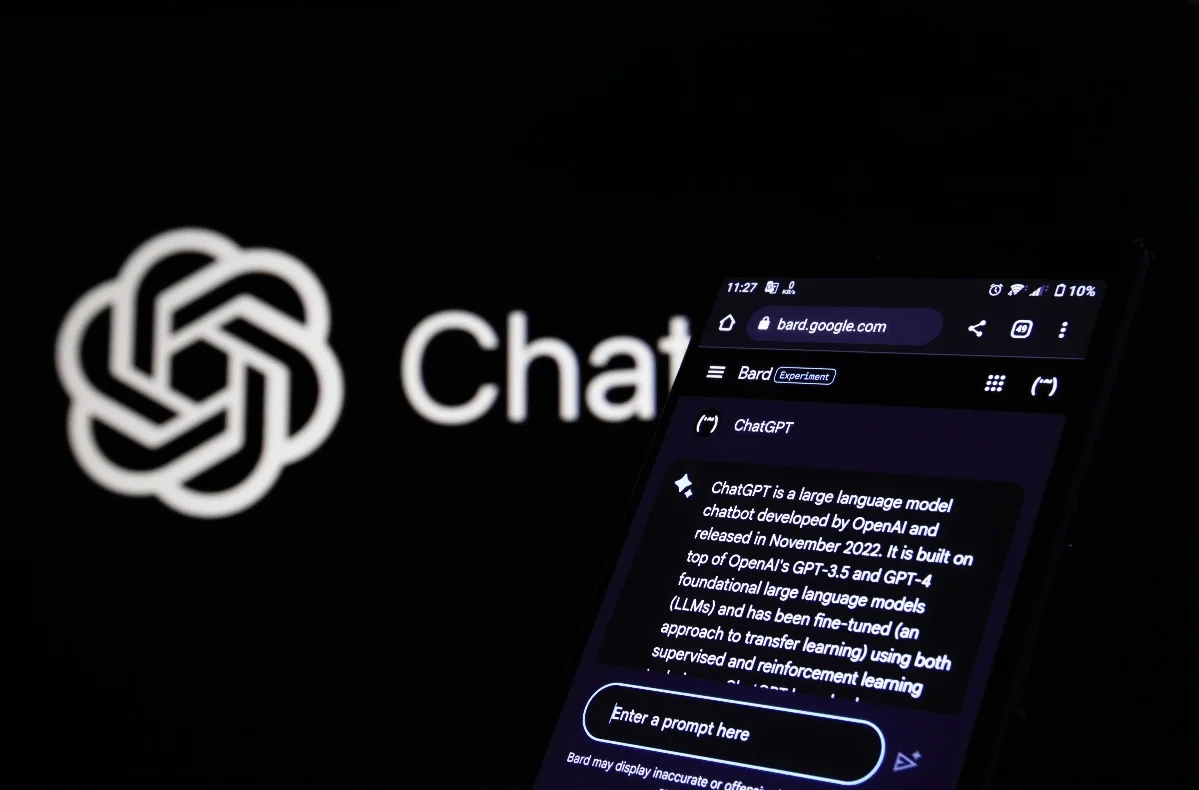
Defining AI Chatbots
AI chatbots, a fusion of artificial intelligence (AI) and chatbot technology, are designed to simulate human conversation. Unlike basic chatbots that follow rule-based responses, AI chatbots leverage AI and natural language processing (NLP) to understand, interpret, and respond to user queries in a more human-like manner. These chatbots are not just programmed to follow scripts; they learn from interactions, enhancing their ability to manage complex customer queries and streamline interactions.
Historical Evolution of Chatbots
The journey of chatbots began with simple, rule-based systems that could answer only specific, pre-defined questions. The first chatbot, ELIZA, created in the 1960s, marked the beginning of this evolution. However, it was the integration of AI and NLP that truly transformed chatbots. This evolution from simple chatbots to intelligent chatbot solutions capable of understanding natural language and context has been pivotal in their widespread adoption.
The Role of NLP and AI in Chatbots
NLP and AI are the building blocks of modern chatbots. NLP allows chatbots to understand and process human language, turning spoken words and text into structured data that the AI can analyze. This capability enables chatbots to handle a wide range of user intents, from answering questions on platforms like Facebook Messenger to providing customer support.
AI, particularly machine learning and neural networks, enables chatbots to learn from past interactions. This learning process is crucial for improving the chatbot’s accuracy in understanding and responding to user inputs. AI-driven chatbots can recognize patterns in data, adapt to user preferences, and even perform sentiment analysis to gauge the emotional tone of conversations.
Together, AI and NLP empower chatbots to seamlessly integrate into various chatbot platforms, offering custom responses and enhancing user experiences. Whether it’s through conversational bots on websites or virtual assistants in apps, AI chatbots are reshaping how businesses engage with their target audience, making every interaction more efficient and personalized.
Types of AI Chatbots

AI chatbots have evolved into diverse forms, each serving unique functions and industries. Understanding these variations is crucial for businesses looking to incorporate artificial intelligence into their operations.
Rule-Based vs. AI-Driven Chatbots
Rule-Based Chatbots:
Function: Operate on predefined rules and regular expressions.
Interaction: Limited to specific user queries they are programmed for.
Use Case: Suitable for basic customer service tasks where user asks are predictable.
Limitation: Cannot handle complex, nuanced conversations.
AI-Driven Chatbots:
Function: Utilize natural language processing (NLP) and machine learning.
Interaction: Capable of understanding natural language and learning from interactions.
Use Case: Ideal for personalized customer experiences and handling a wide range of user intents.
Advantage: Continuously improve with more data and user interactions.
Task-Oriented vs. Conversational Chatbots
Task-Oriented Chatbots:
Purpose: Designed to perform certain tasks following function-based commands.
Structure: Often rule-based and operate within a limited scope.
Example: Virtual assistants in apps for booking appointments or setting reminders.
Conversational Chatbots:
Purpose: Aim to simulate human-like interactions and engage in chatbot conversations.
Structure: Typically AI-driven, using advanced NLP models and deep learning.
Example: Customer support chatbots on websites that provide instant responses and assistance.
Industry-Specific Examples
E-commerce: Custom chatbots help in product recommendations, tracking orders, and answering customer queries.
Healthcare: AI chatbots assist in symptom checking, appointment scheduling, and providing health advice.
Banking: Chatbots in banking use NLP tools for financial advice, transaction inquiries, and fraud alerts.
Education: Chatbot platforms in education facilitate course navigation, administrative queries, and student support.
Each type of chatbot, whether rule-based or AI-driven, task-oriented or conversational, offers unique advantages. The choice depends on the specific needs of the business, the complexity of user queries, and the level of interaction required. As chatbot development continues to advance, the potential for custom chatbots to transform customer engagement and streamline interactions grows exponentially.
The Architecture of AI Chatbots

The architecture of an AI chatbot is a complex framework that integrates various components to ensure seamless and intelligent interactions. Understanding these key elements is essential for anyone looking to build their own chatbot or delve into chatbot development.
Key Components of AI Chatbot Architecture
User Interface (UI):
Function: The front-end through which users interact with the chatbot.
Importance: Determines the ease of use and accessibility of the chatbot.
Variants: Can range from simple text-based interfaces to more sophisticated ones incorporating voice or even virtual reality.
Processing Unit:
Role: Interprets user inputs and determines the appropriate response.
Components: Includes parsers and classifiers to understand user intent and context.
Challenge: Must accurately decipher various forms and nuances of natural language.
Machine Learning and Neural Networks:
Purpose: Enable the chatbot to learn from past interactions and improve over time.
Mechanism: Utilizes training data to refine algorithms and response accuracy.
Evolution: Continuously evolves to handle complex queries more effectively.
Backend Services:
Function: Supports the chatbot with necessary data retrieval and action execution.
Integration: Often linked with databases, third-party services, and internal systems.
Scope: Ensures the chatbot can perform a wide range of tasks beyond basic conversation.
Role of NLP and Machine Learning in Chatbots
Natural Language Processing (NLP):
Core Function: Allows chatbots to process and understand human language.
Techniques: Utilizes NLP tasks like named entity recognition and sentiment analysis.
Result: Enhances the chatbot’s ability to engage in natural, human-like conversations.
Machine Learning Algorithms:
Application: Used to predict user intent and generate relevant responses.
Adaptation: Helps the chatbot to learn from user interactions and refine its responses.
Challenge: Requires continuous optimization to handle the nuances of human conversation effectively.
In summary, the architecture of an AI chatbot is a sophisticated blend of user interface design, advanced processing capabilities, machine learning, and robust backend services. This combination enables the chatbot to not only understand and respond to user queries but also to learn and adapt, making each interaction more efficient and personalized.
Building an AI Chatbot: A Step-by-Step Guide

Creating an artificial intelligence chatbot involves a series of crucial steps, each contributing to the development of an efficient and responsive digital assistant. This guide outlines the process from conception to deployment.
1. Identifying Purpose and Scope
Define Objectives: Determine what you want your chatbot to achieve. Is it for customer service, sales, or something else?
Understand the Audience: Tailor your chatbot to the needs and preferences of your target users.
Scope of Functionality: Decide the range of capabilities your chatbot will have, from simple queries to complex problem-solving.
2. Choosing the Right Platform and Tools
Platform Selection: Choose a chatbot platform that aligns with your objectives. Consider factors like scalability, integration capabilities, and user interface options.
Toolset: Select tools for development, such as NLP models, neural networks, and machine learning tools. Tools like Google Text-to-Speech can enhance the chatbot’s interaction capabilities.
3. Designing Conversation Flows and User Interactions
Conversation Design: Map out the chatbot’s conversation flows. This includes greeting messages, responses to common queries, and pathways for different conversation scenarios.
User Interaction: Design the chatbot to handle various types of user inputs, ensuring it can manage both expected and unexpected queries.
Personalization: Incorporate elements that allow the chatbot to offer personalized experiences, adapting to preferences of users over time.
4. Training the Chatbot
Data Collection: Gather relevant data to train your chatbot. This includes typical user questions, common phrases, and contextual information.
Machine Learning: Utilize learning algorithms to process and learn from the training data. This step is crucial for the chatbot to understand and respond accurately to user requests.
Refining NLP Models: Continuously refine your NLP model to improve the chatbot’s language processing capabilities.
5. Testing and Deploying the Chatbot
Initial Testing: Conduct thorough testing to identify and fix any issues in conversation flows, understanding of user requests, and response accuracy.
User Feedback: Implement a mechanism for collecting user feedback, which is vital for ongoing improvements.
Deployment: Once satisfied with its performance, deploy the chatbot on the chosen platform.
Monitoring and Updating: Continuously monitor the chatbot’s performance and make necessary updates to ensure it remains effective and relevant.
Addressing Challenges
Handling Complex Queries: Equip your chatbot to handle complex requests by integrating advanced NLP techniques and machine learning algorithms.
Scalability: Ensure your chatbot can scale up to handle increased user interactions and evolving functionalities.
User Privacy and Security: Implement robust security measures to protect user data and privacy.
Summary
Building a chatbot is a journey that involves careful planning, selection of the right tools, and continuous refinement. By following these steps, you can create a chatbot that not only serves its intended purpose but also offers a dynamic and engaging user experience. Remember, the success of a chatbot lies in its ability to evolve and adapt to the changing needs and preferences of its users.
Integrating AI Chatbots into Business Operations

The integration of AI chatbots into business operations marks a significant shift in how companies interact with their customers. These digital assistants offer streamlined, efficient customer service and engagement, enhancing the overall user experience.
Enhancing Customer Service with AI Chatbots
Immediate Responses: AI chatbots provide instant answers to customer inquiries, reducing wait times and improving satisfaction.
24/7 Availability: Unlike human staff, chatbots are available around the clock, offering consistent support anytime.
Personalized Interactions: Through advanced algorithms, chatbots can offer tailored recommendations and solutions to individual customers.
Case Studies of Successful AI Chatbot Integrations
Retail Industry: A leading online retailer implemented a chatbot for handling customer inquiries about order status and product information. The result was a 40% reduction in customer service calls and a significant improvement in customer satisfaction ratings.
Banking Sector: A multinational bank introduced a chatbot for assisting customers with account inquiries, transaction processes, and financial advice. This led to a 30% decrease in call center volume and an increase in transaction efficiency.
Healthcare Services: A healthcare provider used a chatbot to schedule appointments, provide medical information, and remind patients of upcoming visits, leading to better patient engagement and reduced administrative workload.
Scrile’s Approach to Custom AI Chatbot Solutions
Tailored Solutions: Scrile focuses on developing custom bots that align with specific business needs and goals.
Integration with Existing Systems: Scrile’s chatbots are designed to seamlessly integrate with a company’s existing digital infrastructure, ensuring a smooth transition and minimal disruption.
User-Centric Design: Emphasizing user experience, Scrile’s chatbots are developed with intuitive conversation flows and user-friendly interfaces.
Continuous Improvement: Post-deployment, Scrile provides ongoing support and updates to ensure the chatbot remains effective and up-to-date with the latest technological advancements.
Summary
AI chatbots represent a transformative tool for businesses, offering enhanced customer service, personalized engagement, and operational efficiency. Scrile’s bespoke chatbot solutions exemplify the potential of these digital assistants in revolutionizing business-customer interactions across various industries.
Introduction to Scrile: Case Study

Comprehensive AI Solutions by Scrile
Scrile stands at the forefront of AI chatbot development, offering comprehensive solutions that blend technological innovation with user-centric design. Our approach is rooted in a deep understanding of our clients’ unique needs, ensuring the delivery of AI chatbots that are not just technologically advanced but also intuitive and seamlessly integrated into business operations.
Case Study: Advanced AI Assistant for Managers and Entrepreneurs
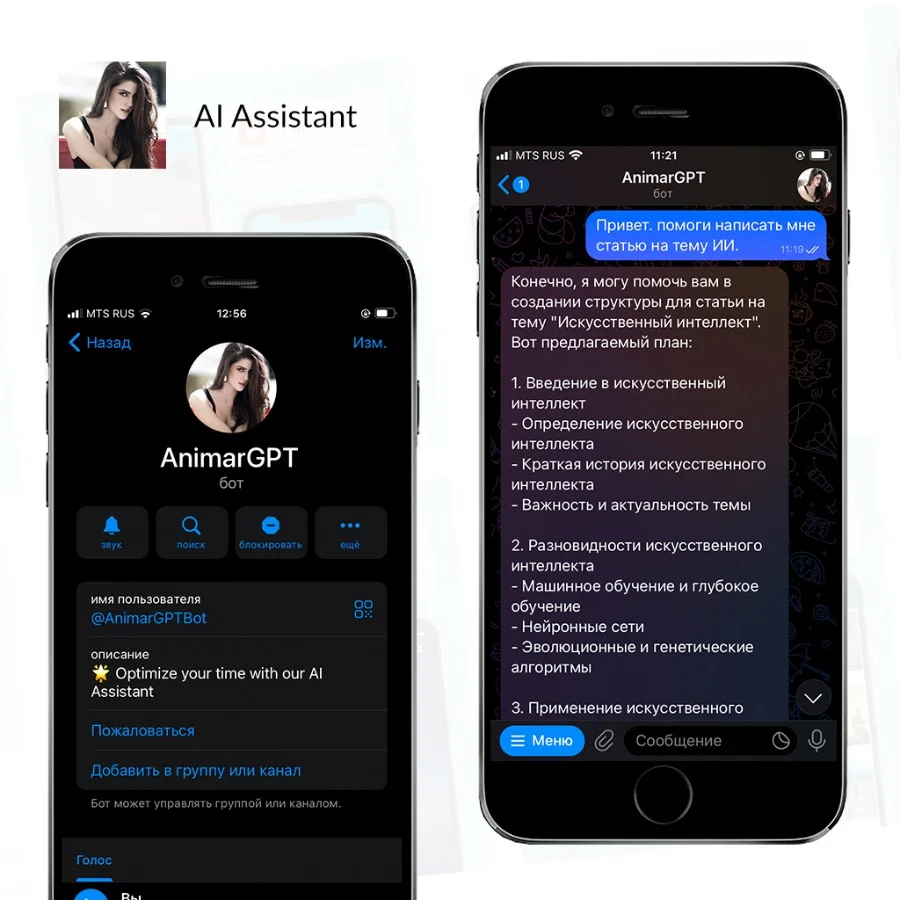
Project Overview: We developed an advanced AI assistant with sophisticated voice command recognition capabilities, specifically designed for managers and entrepreneurs.
Rapid Development: This project was a testament to our efficiency, completed in just 21 days by a dedicated team of two specialists.
Features and Functionality: The AI assistant excels in enhancing content quality through text editing and image generation, showcasing our ability to deliver high-quality, efficient AI solutions swiftly.
Case Study: The KimModelBot
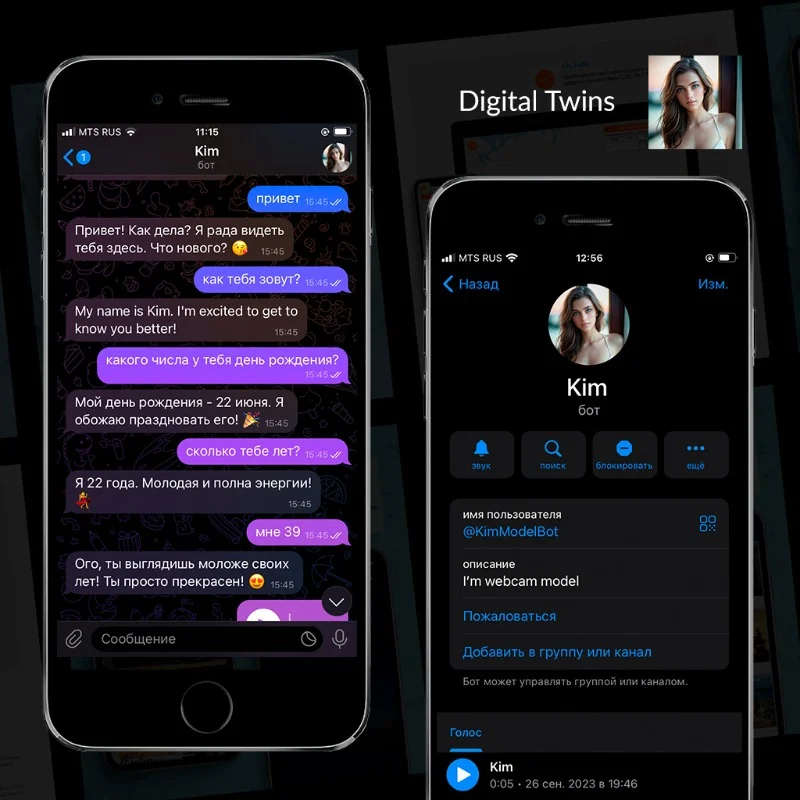
Project Insights: The KimModelBot, a digital twin designed for online engagement, highlights our expertise in AI chatbot creation.
Efficient Execution: Developed by three specialists in 26 days, this bot can converse, send photos, and videos, demonstrating our capability in rapid and effective AI development.
Diverse Portfolio: Our experience extends to domain monitors and versatile AI assistants capable of various chat modes, including code assistance and psychological support.
Scrile’s Methodology in AI Virtual Assistant Development
Client-Centric Approach: Our process begins with a thorough understanding of the client’s specific requirements.
Design and Development: We focus on creating AI-powered avatars and virtual assistants that are both technologically robust and user-friendly.
Pre-Developed Features Integration: Our range of pre-developed features accelerates the development process and ensures tailored solutions for each business’s unique needs.
Versatility: Our AI solutions are adept at handling diverse tasks, from phone call management to messaging app support.
Summary
At Scrile, we pride ourselves on our ability to create chatbots that improve customer service and engagement. Our case studies, from advanced AI assistants to the KimModelBot, exemplify our commitment to delivering custom, efficient, and user-friendly AI solutions. Whether it’s building a simple chatbot or incorporating complex neural networks, we navigate the numerous challenges of artificial intelligence development to provide crucial, step-by-step guidance in creating effective chatbot solutions.
Challenges and Solutions in AI Chatbot Development

Navigating Common Challenges in Chatbot Development
Developing an effective chatbot involves overcoming several key challenges, each requiring a nuanced approach:
Understanding Complex Queries: Chatbots often struggle with interpreting and responding to intricate user requests. The solution lies in enhancing the chatbot’s ability to analyze and process natural language, using advanced neural networks and NLP techniques.
Context Management: Maintaining the context of a conversation is crucial for a chatbot to provide coherent and relevant responses. Implementing context-aware algorithms helps in tracking conversation history and preferences, enabling more personalized interactions.
Continuous Learning and Adaptation: A chatbot must evolve with user interactions. Incorporating feedback loops and continuous data updates ensures that the chatbot remains effective and up-to-date.
Effective Training and Data Management Strategies
Diverse and Comprehensive Training Data: Building a robust dataset that covers a wide range of possible interactions is essential. This includes incorporating various speech patterns, colloquialisms, and potential user intents.
Iterative Training Approach: Regularly updating the chatbot with new data and refining its algorithms helps in adapting to changing user behaviors and trends.
Utilizing NLP Models: Leveraging advanced NLP models can significantly improve the chatbot’s ability to understand and process human language, making interactions more natural and efficient.
Ensuring Privacy and Security
Data Encryption and Secure Channels: Implementing strong encryption protocols for data transmission and storage is vital to protect user privacy.
Compliance with Privacy Regulations: Adhering to privacy laws and regulations, such as GDPR, ensures that user data is handled responsibly.
Regular Security Audits: Conducting frequent security assessments helps in identifying and mitigating potential vulnerabilities in chatbot interactions.
In the realm of bot development, addressing these challenges is an essential step towards creating a chatbot that is not only functional but also secure and user-friendly. By focusing on effective training, privacy measures, and data management, developers can build chatbots that seamlessly integrate into business operations, enhancing user experiences and streamlining interactions.
Future of AI Chatbots

Emerging Trends in Chatbot Technology
The landscape of chatbot technology is rapidly evolving, driven by significant advancements in underlying technologies and changing user expectations. Here are some key trends shaping the future of chatbots:
Enhanced Natural Language Understanding: The integration of sophisticated neural networks is pushing the boundaries of how chatbots interpret and respond to human speech. This evolution is making chatbots more adept at understanding nuanced conversation and providing relevant responses.
Personalization and Predictive Analytics: Future chatbots are expected to leverage user data more effectively, offering personalized experiences and anticipatory responses based on user behavior and preferences.
Voice-Enabled Functionality: The rise of voice technology is leading to more chatbots capable of handling speech, making interactions more natural and accessible.
Potential Impact of Technological Advancements
Broader Application Spectrum: As chatbots become more intelligent and versatile, their applications will expand beyond customer service to include sectors like healthcare, education, and personal assistance.
Improved User Engagement: With advancements in NLP and neural networks, chatbots will offer more engaging and human-like conversations, enhancing user experiences.
Streamlined Business Operations: Advanced chatbots will enable businesses to automate more complex tasks, leading to increased efficiency and cost savings.
Summary
The future of chatbots is marked by continuous innovation, with emerging technologies enabling more sophisticated, intuitive, and useful chatbot interactions. As these technologies evolve, the potential for chatbots to transform various aspects of business and daily life becomes increasingly evident.
Conclusion
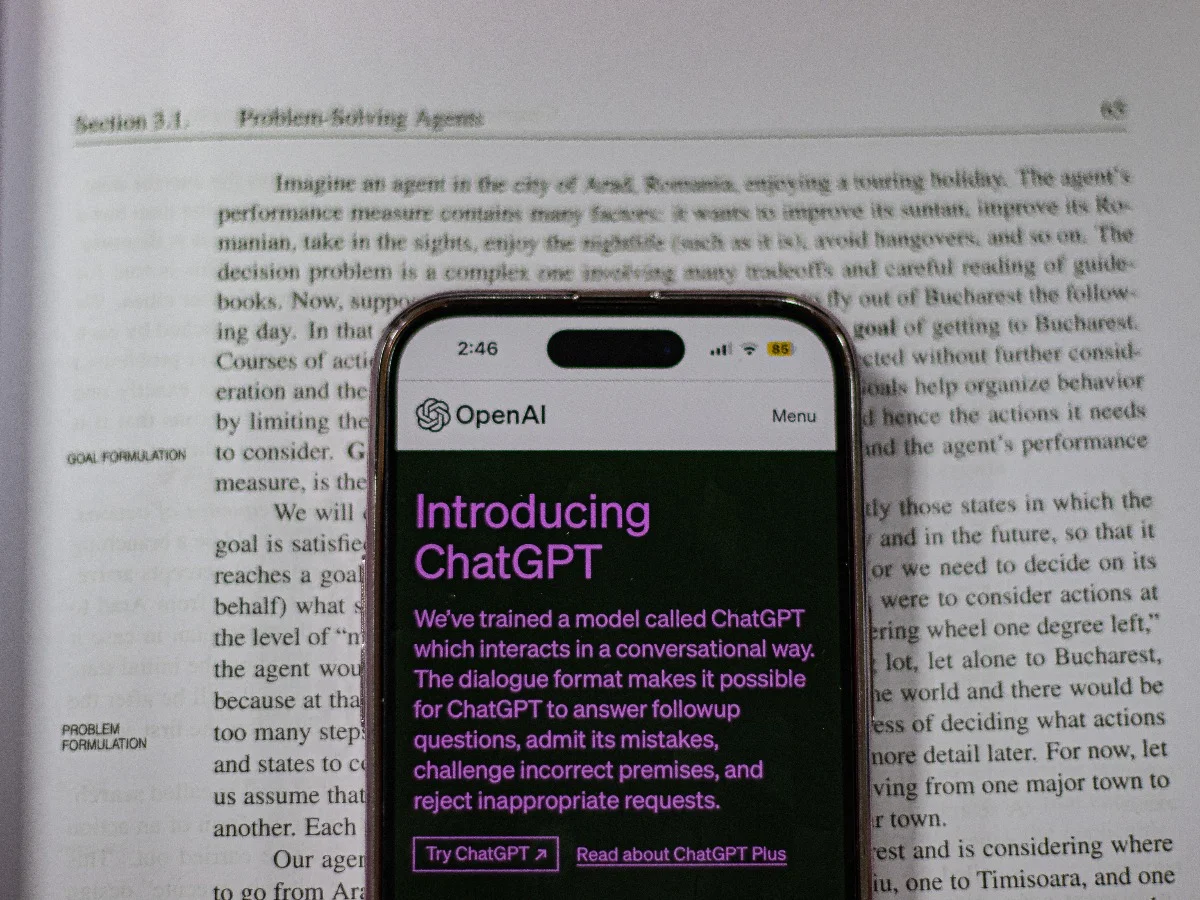
In conclusion, the journey of chatbot evolution, from basic chatbots to sophisticated, neural network-enhanced conversational agents, highlights the significant role of chatbot-based solutions in modern business operations. Incorporating artificial intelligence into chatbots has revolutionized user interactions, offering more intuitive and efficient communication. Whether it’s through enhancing customer service or streamlining business processes, the potential of chatbots is immense. For those looking to create a chatbot, Scrile offers comprehensive services, blending expertise and innovation to deliver tailored chatbot solutions. Embrace the future of digital interaction with Scrile’s cutting-edge chatbot technologies.
FAQ
Can I create my own AI chatbot?
Absolutely! Creating your own chatbot involves understanding the basics of chatbot conversation mechanics and incorporating artificial intelligence. You can start with a basic chatbot and gradually integrate more complex features like neural networks for enhanced interaction capabilities.
How are AI chatbots made?
AI chatbots are developed by combining elements of natural language processing and neural network technology. This process involves designing conversation flows, setting up the chat bot to recognize various user intents, and training it with a significant amount of conversational data to ensure it can respond accurately.
How to build generative ai chatbot?
Building a generative AI chatbot requires a deeper understanding of neural networks and natural language processing. These chatbots generate responses from scratch, which means they need extensive data to learn how to formulate relevant and coherent replies.
How to make AI chatbot using Python?
Python is a popular choice for chatbot development due to its powerful libraries for AI and natural language processing. You can start by using Python frameworks like TensorFlow or PyTorch for neural network implementation and libraries like NLTK for processing human speech. There are numerous chatbot tutorials available that can guide you through the process step by step.
Read also
Dating Landing Page: Design Tips and Best Practices
Learn how to create an effective dating landing page with design tips and best practices to attract and convert visitors.
Build a Dating Website: Comprehensive Guide
Discover a comprehensive guide to building a dating website, covering planning, design, development, and launch strategies.
How to Create a Dating Business: Key Steps
Explore the key steps to starting a successful dating business, from market research and business planning to platform development and user acquisition.
How to Create a Website Like OnlyFans
Learn how to create a website similar to OnlyFans, including essential features, technical requirements, and monetization strategies.
How to Build a Consulting Website: Essential Tips
Discover essential tips for building a consulting website, including design, content creation, and strategies for attracting clients.